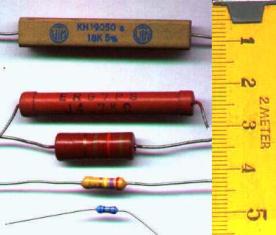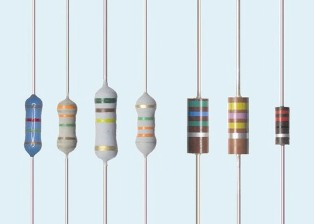Resistor characteristics
Resistors allow you to control the values of currents and voltages in the electrical circuit. Resistors, for example, provide bias mode for the transistor in an electrical signal amplifier. By measuring the voltage across the resistor, you can adjust the emitter and collector currents of the transistor. With the help of resistors, current and voltage dividers are made in measuring devices.
The electrical characteristics of a resistor are largely determined by the material it is made of and its design.
When choosing the type of resistor for a particular application, the following parameters are usually considered:
a) the required resistance value (Ohm, kOhm, MOhm),
b) accuracy (possible deviation,%, of resistance from the value indicated on the resistor),
(c) the power that the resistor can dissipate,
F) temperature coefficient of resistance resistor RT = R20 [1 + α (Т — 20О )], where α — temperature coefficient of resistance.
For example, for a metal film a = (5 — 100) x 10-6,
e) resistor stability: this refers to the percentage change in resistance of the resistor during operation,
f) Noise properties: refers to the equivalent voltage of the noise generated by the resistor.
For points "e" and "f", most manufacturers usually give a qualitative assessment of the properties of the resistors, characterizing the resistors as, for example, highly stable or low noise. Resistors with tolerances of ± 2% or less are called high precision resistors.
High stability, low noise and high precision resistors are required only in special cases. For example, they are used in the input stages of small-signal instrument amplifiers. Their widespread use is limited only by the high cost of these devices. Carbon composite resistors are only used in power supplies and power amplifiers.
Ceramic resistors are only used in power supplies and power amplifiers. Glass-clad resistors find a wide range of applications, while aluminum-clad resistors are used only in amplifiers and small-signal instruments.
Characteristics of resistors made of different materials
Resistor parameter
Resistor material
Carbon Composite Carbon Film Metal Film Metal Oxide Resistor Resistance Range, Ohm 2.2 to 106 10 to 10×106 1 to 106 10 to 106 Accuracy ±10 ±5 ±1 ±2 Power, W 0.125 — 1 0.25 — 2 0.125 — 0.5 0.25 — 0.5 Stability poor enough excellent excellent
Resistance rating and resistor accuracy. The approximate value of its resistance is always marked on the housing of the resistor. So, a resistor marked 100 Ohm ± 10% can have any resistance in the range of 90 to 110 Ohm. The resistance of the resistor marked 100 ohms ± 1% varies from 99 to 101 ohms.
As a rule, all resistors produced by the industry are combined in series. The number of nominal resistance values within a series is determined by the accepted accuracy. For example, to cover the entire possible range of resistance values from 1 to 10 using resistors with an accuracy of ± 20%, it is enough to have a set of six basic values (E6 series).
The E12 series contains 12 basic resistance values with an accuracy of ± 10%. The E24 series contains 24 basic resistor values with an accuracy of ± 5%.
Each series contains 6 or 7 groups of resistors whose resistances differ by a factor of 10. This means that the corresponding resistance group is obtained by multiplying the base value by 1, 10, 100, 1 kΩ, 10 kΩ, 100 kΩ, 1 MΩ .
An example. The bias circuit of the amplifier stage requires a current of 100 μA (± 10%) with a constant voltage source of 5 V. Selection of the type of resistor and its resistance is required. Ohm's Law Resistance:
R = U / I = 5/100 = 50kΩ
The closest to the calculated resistance value (E24 series) is 51 kOhm. In this case, a current of 98 μA will be provided, which differs from the required value by 2%. Given a resistance accuracy of + 5%, we get a possible current variation range of 93 to 103 μA, which is well within the specified tolerance of ± 10%.
Power released in the resistor P = UI = 5 x 100 x 10-6 = 500 x 10-6 W is very small. Therefore, a carbon film resistor with a nominal power of 0.25 W is suitable. If a low noise amplifier is required, then a metal oxide resistor should be taken.

Small notes and tips
The maximum power a resistor can dissipate depends on the ambient temperature. As this temperature increases, the power decreases. To increase the reliability of the resistor, a large power reserve must be provided.
In cases where it is required to have several resistors of the same nominal value, it is recommended to use thick film resistor arrays manufactured in type D.AlzL and SIL packages instead of discrete elements. These are E12 series resistors with ratings from 33 to 1000m.
Wired resistors have significant inductance, therefore it is impractical to use them in high frequency and pulse circuits. At very high frequencies (above 30 MHz), carbon and metal film resistors can also have appreciable inductive resistance due to the length of their pins, which must be shortened as much as possible.
The insulation quality of glass resistors deteriorates with increasing temperature. Therefore, in maximum power dissipation modes, contact of these resistors with any conductive surfaces should be avoided.

